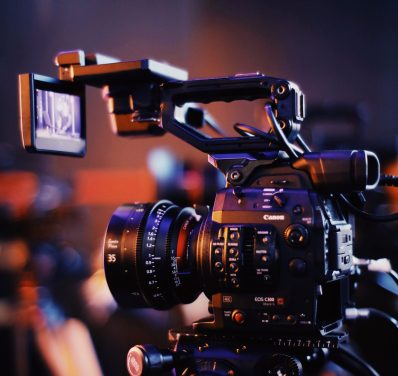We here at Arty-Shock are being asked many times by customers what is it exactly that we do.
We decided to write a lengthy and in-depth explainer demonstrating the many layers and complexity of our work. This guide, however, does not only serve as an explainer about our corporate video production process experience but also a comprehensive how-to for someone who wants to do the work themselves. We are happy to share our experience in corporate video productions and not only inform you but support you in this process. After all, not everyone can hire a professional team like we have in-house. And with this, let’s start exploring some of the information we have to offer.
If you are looking for a way to boost your brand awareness, engage your audience, and increase your sales, then you have to consider corporate video production. Corporate video production is the process of creating promotional video content for your business, whether it is for marketing, training, communication, or any other purpose. A successful Corporate video production can help you showcase your products and services, tell your story, educate your customers, and inspire your employees. It serves the many forms of general video marketing strategy.
But how do you create a corporate video that stands out from the crowd and achieves your goals? How do you plan, produce and promote a corporate video that delivers results? That’s what this guide is all about. In this guide, we will walk you through the steps of corporate video production, from setting your objectives to measuring your success. We will also share some tips, tricks, and best practices that will help you create effective and engaging corporate videos.
This guide is divided into three sections. It is what we call the three P’s (PPP): Planning, Producing & Promoting: In Section 1 we will cover the essential elements of planning a corporate video production project, such as setting SMART objectives, identifying your target audience, crafting your message, and more. In section 2 we will cover the key elements of producing a corporate video, such as hiring or assembling a corporate video production company or team, choosing or hiring the right equipment and software, scouting and securing locations and permits, editing and polishing your corporate video content, and everything else you need to know about. And in section 3 we will cover the key elements of promoting a corporate video, such as optimizing your video for SEO and social media platforms and choosing the right channels and platforms to distribute your video.
By the end of this guide, you will have a clear understanding of how to create a corporate video that works for your business as a part of the whole video marketing strategy. You will also have some practical tools and resources that will help you along the way. So let’s get started!
Section 1: Planning Your Corporate Video
- Identifying your target audience and their needs
- Crafting your key point and call to action
- Choosing the right type and style of corporate video for your purpose
- Writing a video brief and a script
- Creating a storyboard and a shot list
- Budgeting and scheduling your corporate video production

Setting SMART objectives for your video
The first step in planning your corporate video is to set SMART objectives. SMART stands for Specific, Measurable, Achievable, Relevant, and Time-bound. These criteria will help you create clear and realistic goals for your video content.
Some examples of SMART objectives for corporate videos are:
- To increase brand awareness by 20% among our target market in the next 6 months
- To generate 100 leads from our website by showcasing our new product features in a 2-minute explainer corporate video
- To reduce customer support calls by 50% by creating a series of 5-minute tutorial videos on how to use our software
- To improve employee engagement by 30% by sharing a 3-minute testimonial video from our happy clients
To set SMART objectives for your corporate video, you need to ask yourself some questions, such as:
- What is the purpose of this video? What do you want to achieve with it?
- Who is the target audience for this video? What are their needs, challenges, and preferences?
- How will you measure the success of this corporate video? What metrics will you use to track its performance?
- Is this objective realistic and attainable? Do you have the resources and capabilities to achieve it?
- How relevant is this objective to your business goals and strategy? How will it benefit your company?
- When do you want to achieve this objective? What is the deadline or time frame for this project?
By answering these questions, you will be able to set SMART objectives that will guide your corporate video production process.

Identifying your target audience and their needs
The next step in planning your corporate video production process is to identify your target audience and their needs. Your target audience is the group of people who will watch your video and take action based on it. Your target audience may include potential customers, existing clients, investors, employees, or any other stakeholders.
To identify your target audience and their needs, you need to do some research and analysis that use various methods, such as surveying or interviewing, analyzing data, creating customer profiles, and studying your competitors and their corporate videos content strategies. By identifying your target audience and their needs, you will be able to tailor your corporate video content to suit their preferences, interests, and pain points. You will also be able to choose the right tone, style, language, and format for your video.
Crafting your core message and call to action
The next step in planning your successful corporate video production is to craft your core idea and call to action. Your core message is the main idea or takeaway that you want to convey to your audience through your corporate video. Your call to action is the specific action that you want your audience to take after watching your video.
To craft your primary focus and call to action, you need to consider some factors, such as:
- Your SMART objectives: What are you trying to achieve with this video?
- Your target audience: What are their needs, challenges, and goals?
- Your value proposition: What makes your product or service unique and valuable?
- Your brand identity: What are your mission, vision, values, and personality?
By considering these factors, you will be able to craft a core message that is clear, concise, compelling, and consistent with your brand. You will also be able to craft a call to action that is specific, relevant, urgent, and easy to follow.
Some examples of core messages and calls to action for corporate videos are:
- Key message: Our software helps you streamline your workflow and save time.
- Call to action: Sign up for a free trial today.
- Core message: We are a trusted partner for all your corporate video production needs.
- Call to action: Contact us for a free consultation.
Choosing the right type and style of video for your purpose
The next step in planning your corporate video production is to choose the right type and style of corporate video for your purpose. The type of video refers to the format or genre of the video content. The style of the video refers to the tone or mood of the video content.
There are many types of corporate videos that serve different purposes. Some of the most common ones are:
- Brand videos: These are videos that showcase your company’s mission, vision, values, culture, and personality. They are great for building brand awareness and trust among your audience.
- Explainer videos: These are videos that explain how your product or service works or solves a problem. They are great for educating potential customers about the benefits of choosing you over competitors.
- Testimonial videos: These are videos that feature happy customers or clients sharing their positive experiences with your product or service. They are great for building social proof and credibility among potential customers.
- Tutorial videos: These are videos that teach how to use or get the most out of your product or service. They are great for providing customer support and increasing customer satisfaction.
- Product demo videos: These are videos that showcase the features and functions of your product or service. They are great for generating interest and excitement among potential customers.
There are also many styles of corporate videos that create different impressions on your audience. Some of the most common ones are:
- Professional corporate video: This style uses formal language, high-quality visuals, authoritative voice-over, and minimal music or sound effects. It creates a sense of trustworthiness, expertise, and reliability.
- Casual corporate video: This style uses informal language, casual visuals, conversational voice-over, and upbeat music or sound effects. It creates a sense of friendliness, approachability, and authenticity.
- Humorous corporate video: This style uses witty language, funny visuals, comedic voice-over, and lively music or sound effects. It creates a sense of fun, entertainment, and engagement. It can sometimes also feature animated videos that add another layer to a successful corporate video.
To choose the right type and style of video for your purpose, you need to consider some factors, such as your SMART objectives, your target audience, your core message, and your budget. By considering these factors, you will be able to choose the right type and style of video that suits your purpose and aligns with your brand. In today’s fast-paced digital world, capturing your audience’s attention and keeping it can be a challenge. But, a well-made product video can increase engagement with your audience and give them a better understanding of your product’s features and benefits. As product video specialists with over 10 years of experience, we believe that product videos are an essential component of any successful e-commerce strategy. One of the primary reasons for this is that video increases engagement.
Research has shown that viewers are more likely to watch and engage with videos than other forms of content. According to a recent study, video content on social media channels generates 1200% more shares than text and image content combined. This clearly demonstrates the power of video when it comes to engaging with an audience. An engaging product video showcases your product’s features and benefits in a visually appealing way, providing a better understanding of how your product works and leading to increased sales. By creating an immersive and interactive experience for potential customers, you can establish a stronger emotional connection with your brand. According to a study by Wyzowl, 91% of marketers reported that video has increased their audience’s understanding of their products or services. By creating an engaging product video that showcases your products in action, you can help potential customers understand the value of your products and how they can benefit from them. In conclusion, an engaging product video is a powerful tool that can increase engagement with your audience and ultimately lead to increased e-commerce sales.Writing a video brief and a script
The next step in planning your corporate video is to write a video brief and a script. A video brief is a document that outlines the details and requirements of your corporate video production project. Video scripts are documents that contains the words and directions for your corporate video content.
To write a good video brief, you need to include some information, such as:
- The background information about your company, product, or service.
- The SMART objectives for this project.
- The target audience profile.
- The core message, call to action and the overall marketing strategy.
- The type and style of corporate video that you want.
- The desired length, format, and resolution of the final product.
- The budget and timeline for this project.
- The roles and responsibilities of each team member involved in this project.

To write a good script for your corporate video production, you need to follow some guidelines, such as:
- Use simple, clear, and concise language that matches your tone and style.
- Write in short sentences and paragraphs that are easy to read aloud.
- Use headings, subheadings, bullet points, numbers, etc. to organize your content into sections and make it more approachable for viewers or readers.
- Use transitions to connect your sections and create a logical flow of information or story for viewers or readers.
- Use dialogue to make your content more engaging and personal. Use quotation marks, punctuation, and formatting to indicate who is speaking and how they are speaking.
- Use voice-over to narrate your content or provide additional information or commentary. Use parentheses, italics, and formatting to indicate when voice-over is used and who is speaking.
- Use visuals to illustrate your content or support your message. Use brackets, captions, and formatting to indicate what visuals are used and where they are placed.
- Use sound effects and music to enhance your content or create a mood. Use brackets, descriptions, and formatting to indicate what sound effects and music are used and where they are placed.
Section 2: Producing Your Corporate Video
Once you have planned your corporate video, you are ready to dive into the pre production and production stage. This is where you turn your ideas and scripts into reality as part of your marketing strategy. Corporate video production process involves many assignments that include shooting and recording your video footage and audio, as well as editing and polishing your video content. Since we of course can not teach you here in an article how to become a producer, photographer, videographer, and the skill of editing, this will serve as a very general guide for you as a business owner or someone who is entrusted in the business with this kind of work, to know how and what to expect when you hire such corporate video production company.
In this section, we will cover the key elements of producing a corporate videos, such as: Hiring or assembling a video agency, Choosing or hiring the right equipment and software, Scouting and securing locations and permits, Casting and directing actors or presenters, and much more. So let’s get going.
Hiring or assembling a corporate video production team
If indeed you insist on not hiring any of the corporate video production companies out there, then the first step in producing your corporate video is to hire or assemble a video production team. A corporate video production crew is a group of professionals who have the skills to make a great video and expertise to create high-quality video content, just like us here at Arty-Shock. Depending on the type and style of your video, your team should include the following corporate video production services :

- A producer: The person who oversees the entire project from start to finish. They are responsible for managing the budget, timeline, resources, and communication among all team members and stakeholders.
- A director: The person who leads the creative vision and execution of the project. They are responsible for directing the actors or presenters, choosing the shots and angles, and supervising the editing process.
- A videographer – DOP: The person who operates the camera and captures the video footage. They are responsible for setting up the lighting, framing, focus, exposure, and audio levels.
- An editor: The person who edits the raw footage into a coherent and engaging video. They are responsible for cutting, trimming, rearranging, and adding transitions, effects, graphics, music, voice-over, subtitles, etc.
- A sound engineer: The person who records and mixes the audio for the video. They are responsible for setting up the microphones, adjusting the volume, eliminating background noise, enhancing clarity, etc.
- A graphic designer: The person who creates and adds graphics to the video. They are responsible for designing logos, icons, charts, diagrams, animations, etc.
- A scriptwriter: The person who writes the words for the video. They are responsible for crafting a clear, concise, compelling, and consistent script that matches the tone and style of the video.
- An actor or presenter: The person who appears on screen and delivers the message of the video. They are responsible for memorizing their lines, following directions, expressing emotions, etc.
To hire or assemble a video production team you need to consider some factors like your budget, your timeline, your quality, and your availability. You can hire a professional video production company/agency, which is exactly who we are and what we do. A company that can provide you with a full-service team that can handle everything from planning to promotion.
Alternatively, with a much bigger headache, you can hire individual freelancers or contractors who specialize in different aspects of video production. Or, you can assemble an internal team of employees or volunteers who have some experience or interest in video production. Whatever option you choose, make sure you communicate clearly with your team members about your expectations, objectives, and feedback. Also, make sure you sign contracts or agreements that outline the scope, deliverables, payment, and ownership of the project.

Choosing or hiring the right equipment and software for your corporate video production
The next step in producing your corporate video is to choose or hire the right equipment and software. Naturally, this is the work of professionals. But in order for you to add to your knowledge of the project, we decided to share a bit about what it involves when it comes to us choosing and using equipment & software. Equipment refers to the physical devices that we use to capture and record your video footage and audio. Software refers to the digital tools that we use to edit and polish your video content.
Choosing or hiring the right equipment and software is an acquired knowledge that is important because it affects the quality, efficiency, and corporate video cost of your corporate video. Once again, this is an aspect of video production that people spend a lifetime learning and gaining experience in, but some of the equipment that will be used for your successful video project include A camera and a microphone. a tripod, a lighting kit, and if needed a green screen: The device that creates a uniform background for the video.
Some of the software that you may need for your corporate video will be video editing software such as Adobe Premiere Pro, DaVinci Resolve, Final Cut Pro, iMovie, etc; A graphic design software which is the tool that creates graphics that will be added to your video; and sound editing software. To choose or hire the right equipment and software for good corporate video, you need to consider some factors, such as Your budget, your quality, your availability, and your compatibility: How well do your equipment and software work together?
We wholeheartedly recommend that you work at this stage with experts in the field – a video production team. In fact, unless you have vast experience in the above-mentioned software & equipment from a past life, we think it is crucial that you work with qualified personnel throughout the whole of stage 2.
Scouting and securing locations and permits
Another layer to the complexity of producing a corporate video is dealing with locations and permits. The natural next step is to scout and secure locations and permits. Locations are the places where you shoot your video footage. Permits are the permissions that you need to shoot your corporate video production at certain locations.
Scouting and securing locations and permits is important because it affects the aesthetics, logistics, and legality of your corporate video. Our vast experience in finding locations and dealing with permits taught us that there is a pattern in choosing the locations for your corporate video project. The most common ones are:

- Your office or workplace: This is a convenient and cost-effective location for your corporate production process that showcase your company’s culture, environment, or processes. However, you may need to get permission from your employer or manager before shooting at your office or workplace. You may also need to consider the privacy and safety of your co-workers and clients.
- Your client’s office or workplace: This is a suitable location for shooting corporate videos that feature testimonials, case studies, or demonstrations of your product or service. The same applies here when it comes to permission before shooting and considering the privacy and safety of the client’s employees and customers.
- A studio or a set: This is a professional and controlled location that is our preferred environment. It allows shooting corporate videos that require a specific background, lighting, or sound. However, you may need to pay a fee to rent a studio or a set. You may also need to book in advance and follow the rules and regulations of the studio or set owner.
- An outdoor or public place: This is a natural and realistic location for shooting corporate videos that depict real-life situations, scenarios, or stories. However, you may need to get a permit from the local authorities before shooting at an outdoor or public place. You may also need to consider the weather conditions and potential disruptions from traffic, people, or animals.
To scout and secure locations and permits for your corporate training videos, some research and planning are required. If you insist on taking this complicated task on yourself, we are happy to share the various methods we use, such as:
- Searching online for suitable locations and permits in your area or destination.
- Visiting potential locations in person to check their suitability and availability.
- Contacting location owners or managers to negotiate terms and conditions for using their locations.
- Applying for permits online or in person from the relevant authorities or agencies. By scouting and securing locations and permits for your corporate video, you will be able to find and use the best places for your video content.

Casting and directing actors or presenters
The next step in producing your corporate video is to cast and direct actors or presenters. Actors or presenters are the people who appear on the screen and deliver the message of your corporate videos. They can be professional actors, employees, customers, or anyone else who can represent your brand or product conveying your company’s message in an empowering way.
Casting and directing actors or presenters is important part of the video production process because it affects the credibility, authenticity, and engagement of your corporate video production.
Some of the factors we have learned are important to consider when casting and directing actors or presenters are:
Their appearance: They should look appropriate for the role and the audience. They should also match your brand identity and style.
Their voice: They should sound clear, confident, and expressive. They should also match your tone and language.
Their performance: They should act naturally, convincingly, and professionally. They should also follow your script and directions.
By casting and directing actors or presenters for your corporate video, you will be able to create video content that showcases your brand or product in the best possible way.
Shooting, recording, and editing your video footage and audio
The next step in producing your corporate video is to shoot and record your video footage and audio. This is where you use your camera, microphone, tripod, lighting kit, green screen, and other equipment to capture the images and sounds of your video content. It would be much better though to use here professional help.
Shooting and recording your video footage and audio is important part of the video production process because it affects the quality, consistency, and effectiveness of your corporate video.
The final step in producing your corporate video is to edit and polish your video content. This is where you use your video editing software, graphic design software, sound editing software, and other tools to cut, trim, rearrange, add transitions, effects, graphics, music, and much more to your raw footage and audio.
Editing and polishing your video content is crucial in the overall video production process since it affects the coherence, clarity, and impact of your corporate video. Some of the editing tips we use constantly for polishing video content are: Using a timeline to organize clips and layers into a logical sequence and structure. Using transitions, graphics, effects, and music to enhance clips and create a mood or atmosphere. If needed we use voice-over to narrate and provide additional information or commentary.
By editing and polishing your video content properly, you will be able to create video content that is coherent, clear, and impactful.

Section 3: Promoting Your Corporate Video
After you have produced your corporate video, you are ready to move on to the promotion stage. This is where you use various channels and platforms to distribute and share your video content with your target audience.
Promoting your corporate video is crucial for reaching your target audience and achieving your objectives. In this section, we will cover the key elements of promoting a corporate video, such as:
- Optimizing your video production process for SEO and social media
- Choosing the right channels and platforms to distribute your video
- Creating a landing page or a website for your video
- Using email marketing, paid ads, influencer marketing, etc. to boost your video reach
- Measuring and analyzing your video performance and ROI
Optimizing your video for SEO and social media presence
The first step in promoting your corporate video is to optimize it for SEO (search engine optimization) and social networking sites. SEO is the process of improving the visibility of your website or web page on search engines such as Google or Bing. Social media sites are online services that allow users to create and share content such as Facebook, Twitter, Instagram, YouTube, etc.
Optimizing your video for SEO and social media platforms is principal because it helps you rank higher on search results pages (SERPs) and reach more potential viewers on social media networks.
Some of the tips that you need to follow when optimizing your video for SEO and social media platforms are:
- Choose relevant keywords for your video title, description, tags, and captions. Keywords are words or phrases that describe what your video is about. They help search engines understand what your video is about. They also help users find what they are looking for.
- Write catchy titles, descriptions, tags, and captions for your video. Titles are the first thing that users see when they encounter your video on search engines or social media networks. Descriptions are short summaries that explain what your video is about. Tags are the labels that categorize what type of content you have created. Captions are the texts that appear on the screen along with your audio. They help users understand what you are saying in different languages or contexts.
- Add thumbnails, logos, watermarks, or branding elements to your video. Thumbnails are the small images that represent what your video is about. Logos are the symbols that identify who you are or what you do. Watermarks are transparent images that overlay on top of your video. Branding elements are any visual cues that communicate what makes you unique or valuable. They help users recognize who you are or what you offer.
- Embed links, buttons, or calls to action in your video. Links are clickable texts or images that direct users to another web page or resource. Buttons are clickable icons or shapes that perform a specific action such as play, pause, subscribe, etc. Calls to action are phrases that urge users to take a specific action such as visiting our website, contacting us now, buying now, etc. They help users engage with you or take the next step in their journey.
By optimizing your video for SEO and social media platforms, you will be able to increase the visibility, traffic, and engagement of your corporate video mission.
Choosing the right channels and platforms to distribute your video
The next step in promoting your corporate video is to choose the right channels and platforms to distribute your video. Channels and platforms are the online services or mediums that you use to deliver your video content to your target audience. They can be your own website, social media networks, video hosting sites, email marketing platforms, etc.
Choosing the right channels and platforms to distribute your video is important because it helps you reach your target audience where they are and how they prefer to consume video content.
Some of the factors that you need to consider when choosing the right channels and platforms to distribute your video are:
- Your target audience: Who are they? Where are they? How do they use the internet? What are their preferences and behaviors?
- Your objectives: What are you trying to achieve with this video? What actions do you want your audience to take after watching it?
- Your budget: How much can you afford to spend on distributing your video? What are the costs and benefits of each channel or platform?
- Your resources: How much time and effort can you devote to distributing your video? What are the skills and tools that you need for each channel or platform?
You can use various methods to choose the right channels and platforms to distribute your video, such as:
- Researching the best practices and trends for each channel or platform
- Analyzing the performance and results of your previous or similar videos on each channel or platform
- Testing different channels or platforms with a small sample of your audience or a subset of your video content
- Evaluating the feedback and analytics of your audience on each channel or platform
By choosing the right channels and platforms to distribute your video, you will be able to maximize the reach, exposure, and impact of your corporate video venture.
Creating a landing page or a website for your video
The next step in promoting your corporate video is to create a landing page or a website for your video. A landing page or a website is a web page that showcases your video content and provides additional information or resources for your audience. It can also include links, buttons, or calls to action that direct your audience to take further steps in their journey.
Creating a landing page or a website for your video is important because it helps you provide more value, context, and guidance for your audience.
By creating a landing page or a website for your video, you will be able to create a more engaging and effective online presence for your corporate video project.
Using email marketing, paid ads, and influencer marketing to boost your video reach
The final step in promoting your corporate video is to use email marketing, paid ads, influencer marketing, etc. to boost your video reach. These are some of the strategies that you can use to amplify your video distribution and increase your audience size and engagement.
Email marketing is the strategy of sending emails to your subscribers or contacts to inform them about your video content and encourage them to watch it.
Paid ads are the strategy of paying for advertising space on search engines, social media networks, video hosting sites, etc. to display your video content to a targeted audience.
Influencer marketing is the strategy of collaborating with influential people or organizations in your industry, niche, or market to promote your video content to their followers. Some of the tips that you need to follow when using email marketing, paid ads, and influencer marketing to boost your video reach are:
- Segment your audience based on their demographics, psychographics, and behaviors, and tailor your messages accordingly.
- Craft catchy subject lines, headlines, and captions that capture attention and curiosity.
- Include clear calls to action that direct users to watch your video or take further steps.
- Track and measure the performance and results of each strategy using analytics tools.
Measuring and analyzing your video performance and ROI
The final step in promoting your corporate video is to use email marketing, paid ads, influencer marketing, etc. to boost your video reach. These are some of the strategies that you can use to amplify your video distribution and increase your audience size and engagement.
Email marketing is the strategy of sending emails to your subscribers or contacts to inform them about your video content and encourage them to watch it.
The last step in promoting your corporate video is to measure and analyze its performance and ROI (return on investment). Performance refers to how well your video achieves its objectives. ROI refers to how much value or benefit you gain from investing in producing and promoting your video.
Measuring and analyzing your performance and ROI is vital because it helps you evaluate the effectiveness and efficiency of your corporate video project. It also helps you identify the strengths and weaknesses of your project and helps you improve and optimize future projects.
Some of the metrics that you need to measure and analyze for performance are:
- Views: The number of times people watch all or part of your video.
- Watch time: The total amount of time people spend watching all or part of your video.
- Engagement: The number of times people interact with all or part of your video such as liking, commenting, sharing, subscribing, etc.
- Conversion: The number of times people take action after watching all or part of your video such as visiting another web page, contacting you, signing up for a newsletter, downloading a resource, etc.
Some of the metrics that you need to measure and analyze for ROI are:
- Cost: The total amount of money you spend on producing and promoting all or part of your video.
- Revenue: The total amount of money you earn from producing and promoting all or part of your video such as sales, leads, referrals, etc.
- Profit: The difference between revenue and cost.
- ROI: The ratio between profit and cost expressed as a percentage.
To measure and analyze these metrics, you need to use various tools,
such as:
- Analytics tools provided by search engines, social media networks, video hosting sites, email marketing platforms, etc. such as Google Analytics, Facebook Insights, YouTube Analytics, Mailchimp Reports, and others.
- Analytics tools provided by third-party services such as Vidyard, Wistia, and Vimeo, offer more advanced features and insights for measuring and optimizing video performance and ROI.
Conclusion
Corporate videos are powerful tools for communicating with various audiences such as customers, employees, investors, or stakeholders. They can help you showcase your brand, product, or service; educate your customers; inspire your employees; and more. But creating a corporate video is not an easy task. It requires careful planning, production, and promotion. In this guide, we have covered the steps involved in each stage, as well as some tips, tricks, and best practices for creating effective and engaging corporate videos. We hope this guide has been helpful for you and at the same time, that it is reflecting the complexity and hard work that is needed for the making of a corporate video. But let us sum it up from our rich experience: Hire professionals. We will give you a high-quality result while sparing you with all the work involved. Just have a look at our clients and the work we have done for them to make an easy decision.







